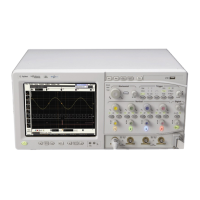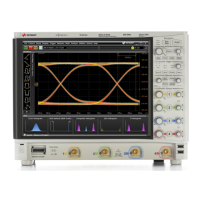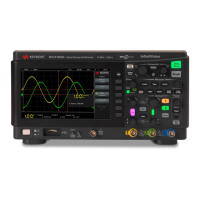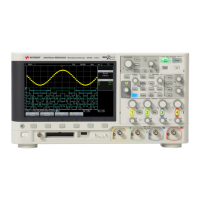Chapter 8: Theory of Operation
Acquisition Theory
156
Time Base The time base provides the sample clocks and timing necessary for data
acquisition. It primarily consists of a reference oscillator, time base IC, and trigger
interpolator pulse stretcher.
• The 10 MHz oscillator provides the timebase reference.
• The time base has programmable dividers to provide the rest of the sample frequencies
appropriate for the time range selected. The time base uses the time-stretched output
of the interpolator pulse stretcher to time- reference the sampling to the trigger point.
The time base has counters to control how much data is taken after the trigger event
(post- trigger data). After enough pre- trigger samples have occurred, the time base IC
sends a signal to the trigger multiplexer (ARM) indicating it is ready for the trigger
event. When the trigger condition is satisfied, the trigger multiplexer sends a signal
back to the time base (SYSTRIG). The time base IC then starts the post-trigger delay
counter. When the countdown reaches zero, the sample clocks are stopped and the
CPU is signaled that the acquisition is complete.
• The Interpolator Pulse Stretcher is a dual- slope integrator that acts as a time- interval
stretcher. When the trigger system receives a signal that meets the programmed
triggering requirements (SYSTRIG), it signals the time base. The time base then sends
a pulse to the pulse stretcher. The pulse is equal in width to the time between the
trigger (SYSTRIG) and the next sample clock. The pulse stretcher stretches this time
by a factor of approximately 1000. Meanwhile, the time base hybrid runs a counter
with a clock derived from the sample rate oscillator. When the interpolator indicates
the stretch is complete, the counter is stopped. The count represents, with high
accuracy, the time between the trigger and the first sample clock. The count is stored
and used to place the recently acquired data in relationship to the trigger point.
Calibration The Calibration circuit provides several signals to the Probe
Compensation and Aux Out outputs. Which signal is driven to the front panel
depends on the current selection from the drop- down menu in the Calibration dialog
box. Available signals for Aux Out include a 715 Hz probe compensation signal, a
pulse representing the trigger event, the timebase clock, or a DC voltage in the
range –2.5 to +2.5 V. The DC voltage is used for self- calibration, and is an output
from a 16- channel DAC. The calibration signals are sent to an analog multiplexer,
which selects the signal that will be sent to the front panel.
Microprocessor Interface The Microprocessor Interface provides control and
interface between the system control and digital functions in the acquisition circuitry.
Analog Interface The Analog Interface provides analog control of functions in the
acquisition circuitry. It is primarily DACs with accurate references and filtered
outputs. The analog interface controls:
• Channel offsets
• Trigger levels
• Two logic trigger functions
Acquisition Modes
The Keysight Technologies oscilloscopes provide two acquisition modes:
•full channel mode
• half channel mode
Full Channel Mode In this mode, the oscilloscope uses all the channel inputs.
Half Channel Mode In this mode, the oscilloscope only uses the odd channel inputs.
The ADC hybrids for the channel 1 inputs are routed to both the channel 1 and
channel 2 ADC hybrids. The hybrids are time- aligned to sample 90° out- of- phase
to yield a sample rate of 4 GSa/s. Channel 3 and channel 4 are combined in the
same way on four channel oscilloscopes.

